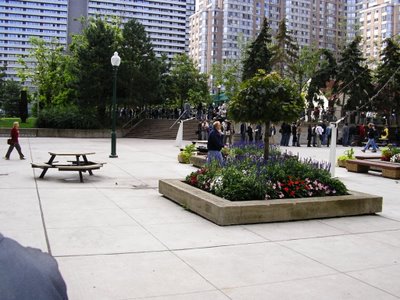Well, another festival done for the year. 26 movies, 46 hours and 7 minutes worth of film, and too many hot dogs from the street.
Things that were done well:
- The festival trailer. Short and to the point, along with all the other trailers (Motorola, Cineplex). The Motorola trailer had a nice variety too (Veronica Tennant, the guy with his nephew Keon, the girl who fled Trans-Carpathia, the intimate visual artist, and the girl who has to go the airport). Hopefully next year will be like this too.
- The volunteers did their usual excellent job of putting up with all the festival-goers, press, and industry.
- The pick up/drop off coupon system was good. There was no question as to how many order forms you needed, and you only had to deal with vouchers if you didn't get all your films.
- The festival recognizing blogs this year was a good step forward.
- While not related to the festival group, the TIFF Reviews site did a great job of putting up descriptions and links to trailers for all the films at the fest, even before the official schedule came out. They also aggregated content from this and a lot of other festival blogs so there was one place to go to read the latest festival news and reviews.
Things that could be improved:
- From the sounds of it, the ticketing system had even more problems this year than last year. It wasn't just the website this year, even the box office was having issues.
- While I got my e-mail confirmations, a number of other people didn't. Not sure if it was a festival or a festival-goer issue or both, but it sounds like even some festival veterans didn't get confirmations.
Other than that, my festival went pretty smoothly. A lot of the things that I thought could have been improved last year were addressed this year.
Of the 26 films I watched this year, below are the ones I liked the best. Note these are only from among the films I actually watched; there was a lot of other good stuff that I didn't get the chance to see.
- Film I liked the best: A toss up between Paris, je t'aime and Everything's Gone Green. Paris, je t'aime makes me want to go to Paris, and the sheer variety of stories, even as short as they were, and the amount of directing and acting talent packed into two hours made it all worthwhile. Everything's Gone Green was a funny, quirky, definitely Canadian film. An honourable mention should go to Pan's Labyrinth.
- Best Japanese film: Hana, although I liked Hula Girls too, but for different reasons. Hana was a bit of different take on the samurai genre, and Hula Girls may have been predictable, but it pulled all the right strings (and apparently, Hula Girls will be Japan's official selection for the Academy Award for Best Foreign Film).
- Best Canadian film: Everything's Gone Green.
- Best Romantic Movie: Paris, je t'aime, although Griffin and Phoenix, as well as Venus, are up there.
- Best Documentary: Office Tigers. It's going to make me very conscious of how I behave at work with my team.
- "WTF?!" Award: The Pervert's Guide to Cinema. I won't be able to look at Chaplin or Hitchcock the same way again.
- Best Looking Film: Renaissance had a very distinct visual style.
- Best Period Piece: Have to give this one to Starter for Ten, if only for its soundtrack.
- Best Film About an Angst-ridden Young Man Who Has a Setback that Teaches Him What's Really Important in Life: Cashback.
- Best Epic Where the Cast Looks Like They Really Need a Bath: Alatriste.
- Best Fusion of Two Things You Would Never Associate in a Million Years: Jade Warrior for combining modern-day Finland with Chinese martial arts.
I still have some more reviews to post up before I completely close off my festival for this year. Note that most of my reviews from past years (I haven't gotten around to this year's yet) are also available on the Internet Movie Database (http://www.imdb.com/) in the entry for each movie. Hopefully people found this blog useful, and I hope to be back next year with more festival stuff, from advanced ticketing info to actual reviews.








